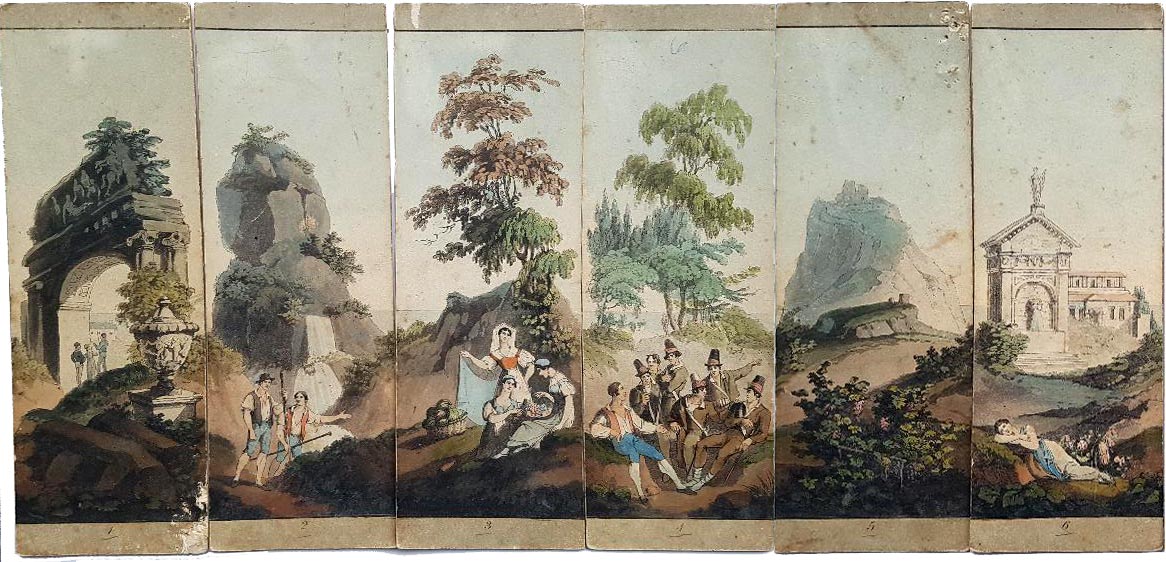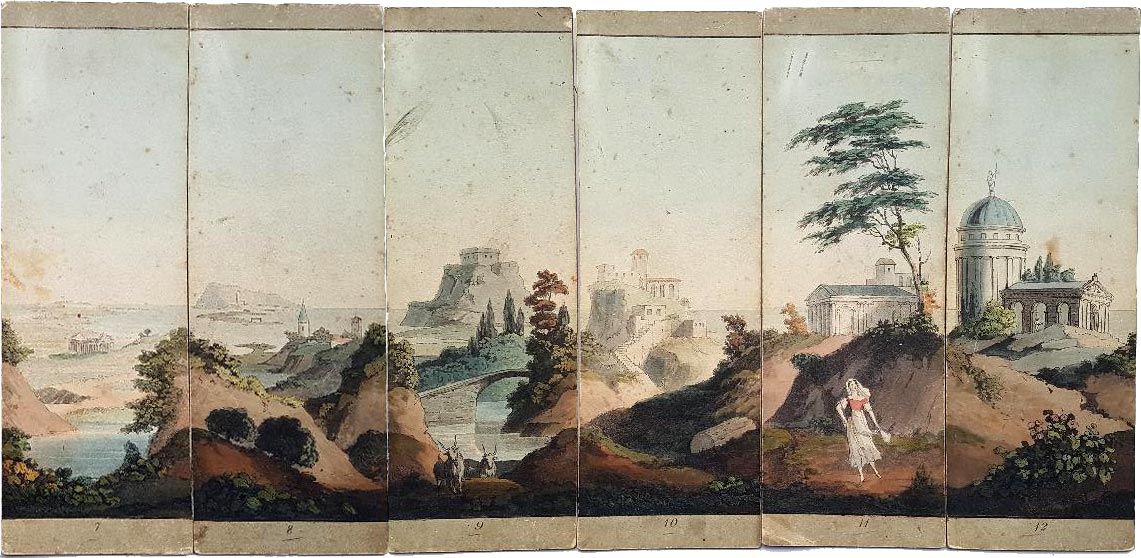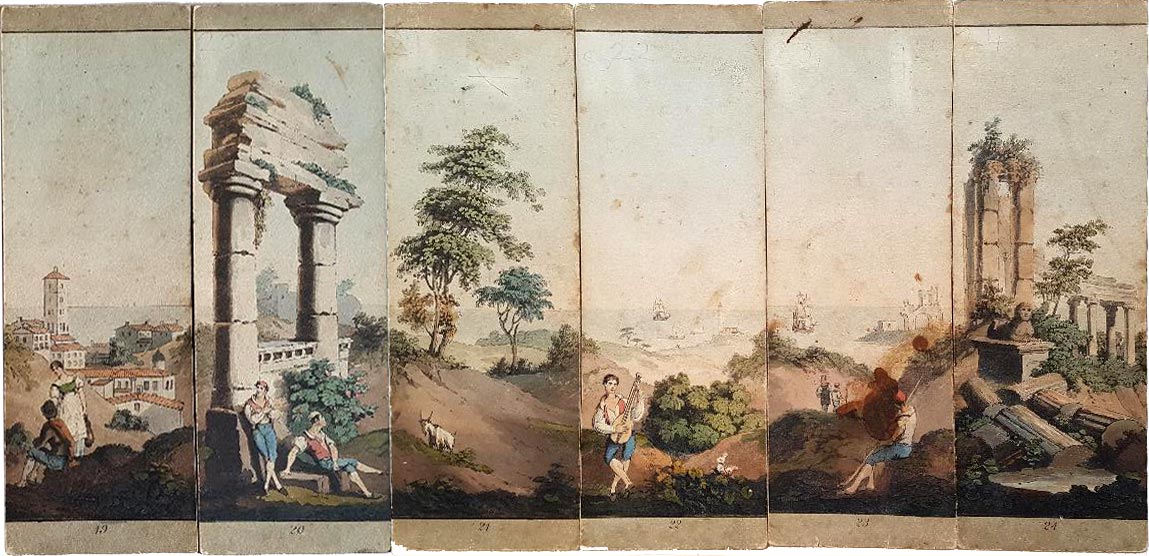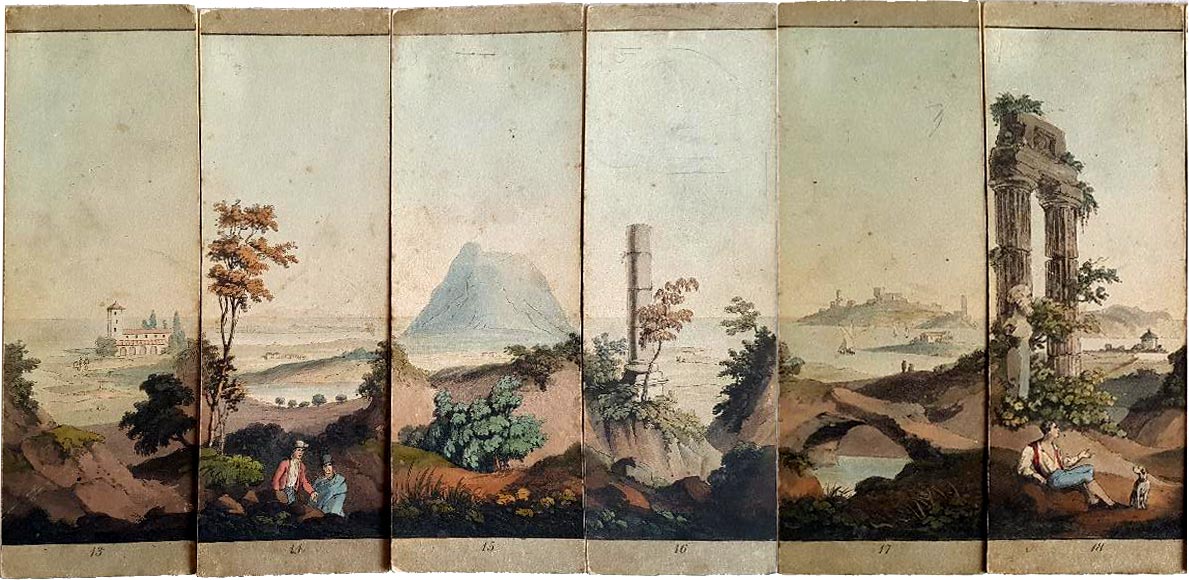Myriorama
Myriorama of Italian scenery, 1824.
The Myriorama was invented in France in c.1823 by Jean-Pierre Brés. The idea is that many different panoramic landscapes may be created by laying a set of illustrated cards in any order. The publisher Samuel Leigh employed artist John Heavside Clark (c. 1771–1863), to create Myrioramas for the English market. The example shown here is of Italian scenery.




Above: Myriorama of Italian scenery, produced by John H. Clark, published by Samuel Leigh, 1824. 24 elongated cards in box. Images courtesy Shirley Ashman.
The game was known under the name of Myriorama; it consisted of up to thirty-two cards presenting fragments of landscapes drawn in such a way that the various pieces could connect indiscriminately with each other; after scrambling the pieces, compositions more or less pleasing could be made at random. As all the parts of trees, rocks, and clouds fitted together perfectly, each person could create a scene according to their taste. Thus it was a form of patience.
REFERENCES

By Simon Wintle
Member since February 01, 1996
I am the founder of The World of Playing Cards (est. 1996), a website dedicated to the history, artistry and cultural significance of playing cards and tarot. Over the years I have researched various areas of the subject, acquired and traded collections and contributed as a committee member of the IPCS and graphics editor of The Playing-Card journal. Having lived in Chile, England, Wales, and now Spain, these experiences have shaped my work and passion for playing cards. Amongst my achievements is producing a limited-edition replica of a 17th-century English pack using woodblocks and stencils—a labour of love. Today, the World of Playing Cards is a global collaborative project, with my son Adam serving as the technical driving force behind its development. His innovative efforts have helped shape the site into the thriving hub it is today. You are warmly invited to become a contributor and share your enthusiasm.
Related Articles

Double Dummy Bridge
In the early 20th century several firms began to promote whist or bridge as a game for two.

Ogdens Beauties & Military cigarette cards
Cigarette cards featuring beauties and military uniforms with playing-card insets.

National Gallery of Art
Fifty-three masterpieces from the collections of the National Gallery of Art, Washington.

Boddingtons Bitter playing cards
Cool-looking courts advertising Boddingtons Bitter, originally brewed in Manchester.

OXO Faces of the Millennium Dinner
Twentieth-century personalities promoting a millennium dinner at the Oxo Tower in London.

Kids Fun Box playing cards
Colourful cards for children with four non-standard suits connected with the natural world.

Tangle Foot Ale
Badger Brewery Tangle Foot strong ale advertising pack.

Late flowering of the Lyon pattern
Faustino Solesio’s late version of the Lyon pattern from about 1870.

Scientific Whist
“Scientific Whist” : standard cards with instructions for play on the faces by Chas Goodall & Son, 1...

Agent Provocateur
Branded lingerie collection in a pack of pin-up playing cards.

Nimbus playing cards
Mike Steer’s weather-themed pack with suits in four colours and backs for cardistry.

Agatha Christie and Playing Cards revisited
Agatha Christie uses card-play as a primary focus of a story, and as a way of creating plots and mot...

The Decadent Deck
Studies in the eroticism of the female body by Inge Clayton.

Historic Shakespeare
“Historic Shakespeare” playing cards featuring Shakespearean characters by Chas Goodall & Son.

CARD-AB Miltenberg
Illustrations by Rita Stern depicting notable landmarks and scenes from the town of Miltenberg in Ge...

Czech National Patterns by S.D. Modiano
Modiano produced cards with the Prague and Trappola patterns in the early 20th century.
Most Popular
Our top articles from the past 28 days

